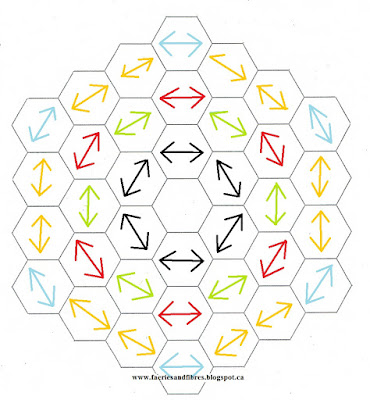In the example above the stripes are all running from a straight edge to a straight edge so that made the cutting easy (I just cut them all from a single strip of fabric). You will notice that the rosette in the middle is also made with a stripe fabric and again the stripes are all running from a straight edge to a straight edge. Let me demonstrate with one of my Road 66 blocks. The centre hexagon is fussy cut and then the first round of hexagons that make the rosette are cut from a directional chevron striped fabric. In this example the stripes all radiate out from the centre.
Notice how the stripe runs from a straight edge to a straight edge. I use regular printer paper to make my hexagons. The beauty of paper is that you can write on it. If you are a beginner draw an arrow on the wrong side of your paper so that once it is basted you can use the arrow to position the stripe.
The second round of hexagons were also cut from a directional fabric. There are twelve hexagons in this round. Notice how the six hexagons that are attached to the straight edge of the previous round have the stripe running from straight edge to straight edge.
If the stripes were to circle the central hexagon the placement of the hexagon on the striped fabric will be reversed. Take a look at this Road 66 block. The fabric that surrounds the central hexagon is a border print.
The hexagons cut from the border print are placed point to point.
The second round is cut from an ombred stripe fabric. The six hexagons whose straight edge connects to the straight edge of the first round will be cut from point to point.
The remaining six hexagons that fit in the "V" are cut so that the stripe runs from straight edge to straight edge.
With each subsequent round the number of hexagons needed will increase by six so the third round would require eighteen hexagons. A fourth round would require twenty-four hexagons. In each round there will be six hexagons cut exactly the same way as those in the first round and any remaining hexagons would be cut the other. Let me demonstratre.
If the stripes were radiating outwards, six hexagons would be cut from straight edge to straight edge.
In round 2 which is made of twelve hexagons, six would be cut from straight edge to straight edge (red arrows) and the remaining six from point to point (green arrows).
In round 3 which is made of eighteen hexagons, six would be cut from straight edge to straight edge (blue arrows) and the remaining twelve from point to point (gold arrows).
A fourth round (not demonstrated here) would be made of twenty four hexagons, six of which would be cut from straight edge to straight edge and eighteen from point to point.
If the stripes were circling the central hexagon, round 2 would be made of six cut from point to point (red arrows) and six cut from straight edge to straight edge(green arrows). In round 3 there would be six hexagons cut from point to point (blue arrows) and twelve cut from straight edge to straight edge (gold arrows).
When I construct my rosettes I make each round an open donut and add it to what I've already stitched. It makes for fast and accurate sewing!
Was this helpful? I sure hope so! Until I post again, happy sewing.
Karen H
























